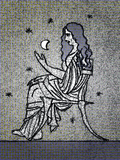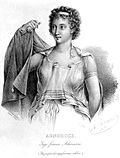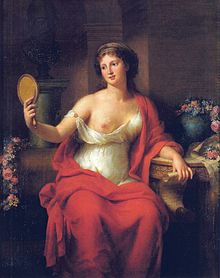List of 999 women of the Heritage Floor / Aspasia
This list describes the place setting for Aspasia on the table of Judy Chicago's art installation The Dinner Party . It is part of the list of 999 women on the Heritage Floor who are assigned to the respective place settings on the table. The names of the 999 women are on the tiles of the Heritage Floor, which is arranged below the table and belongs to the art installation.
description
The installation consists of a three-sided table, each with 13 historical or mythological personalities, thus a total of 39 people, from prehistory to the women's rights movement . These people were assigned a place setting at the table, consisting of an individually designed table runner, an individually designed plate, a goblet, knife, fork, spoon and serviette. The first page of the table is devoted to prehistory up to the Roman Empire , the second to Christianization up to the Reformation and the third from the American Revolution to the women's movement. Each place setting on the table is assigned additional personalities who have received an entry on the tiles of the Heritage Floor, which occupies the space under the table and the center of the space between the sides of the table. This list includes the personalities who are assigned to the Aspasia table setting. Your seat is on the first side of the table.
Hints
In addition to the names as they are used in German transcription or in scientific usage, the list shows the spelling chosen by Judy Chicago on the tiles.
The information on women who do not yet have an article in the German-language Wikipedia is referenced by the individual references listed under comments . If individual information in the table is not referenced via the main article, additional individual references are given at the relevant point. If there are any discrepancies between the information provided in Wikipedia articles and the descriptions of the work of art on the Brooklyn Museum website , this will also be indicated under Comments.
Place setting for Aspasia
Aspasia was founded around 470 BC. Born around 420 BC and died around 420 BC BC She was a philosopher and speaker. Aspasia was the second wife of Pericles . She was born as the daughter of Axiochus and came from Miletus . In Athens , she ran a philosophical salon as host and speaker. She had received her education from her father, in contrast to the women in Athens, who lacked basic rights and education. It was influenced by the Ionic philosophy . Her works have not survived, but Plato's dialogue Menexenosis supposed toreproduce a speech by Aspasia. Since she is mentioned in the records of other philosophers, many famous philosophers probably frequented her salon. In the dialogue Menexenus, Socrates explains that Aspasia was his teacher of rhetoric.
At the same time, however, she is referred to by ancient comedy writers as a hetaera and thus belittled. The comedy poet Hermippos accuses her of acebie and pimp. Pericles was barely able to obtain an acquittal. According to Plutarch, Thargelia of Miletus is said to have been her model. However, this could also be due to the fact that she was a woman from Miletus according to a civil rights law of 451/450 BC introduced by Pericles himself. BC did not have full civil rights, as the full civil rights could only arise from the union of Attic citizens, so her marriage to Pericles was not legally valid. This initially also applied to their son Pericles the Younger , who later was an Athenian general. Here Pericles was able to achieve that his son received civil rights. Pericles died of the Attic plague in 429 and Aspasia married Lysikles, a cattle dealer and follower of Pericles, who, however, lived as early as 428 BC. BC also died. A son also came from this connection.
Elements that can be found in the art of ancient Greece adorn the Aspasia table setting. Your plate is decorated with a flower pattern, which indicates your femininity. This is done in earth tones, which are used in the art and architecture of the 5th century BC. Were used. The table runner is decorated in the manner in which men and women dressed in Aspasia's time. The front and back are designed with draped fabric in the manner of a chiton . Two embroidered, leaf-shaped pins hold the draped fabric on the runner, similar to the decorative clasps that the Greeks used to fasten their robes. The back is also embroidered with six stylized black palmettes of a palm frond. The side edges of the runner are decorated with a floral tendril pattern, which is embroidered in gold, silver and black. It mimics the motifs of many Greek vases and urns. This pattern can be found in the decoration of the initial letter "A" of the name Aspasia on the front of the runner.
| Surname | Spelling on the tile | Date of birth | cultural spatial assignment | Remarks | image |
|---|---|---|---|---|---|
| Aglaonike | Aglaonice | 3rd v. BC to 1st century AD | Ancient Greece | According to legend, a Greek woman from Thessaly , who knew how to magic, was able to “pull down” the moon and was punished for it by the gods. |

|
| Agnodike | Agnodice | about 3rd century BC Chr. | Ancient Greece | First doctor in ancient Greece who is said to have worked as an obstetrician . |

|
| Arete of Cyrene | Arete of Cyrene | around 400 BC Chr | Ancient Greece , Cyrenaic | Ancient Greek philosopher . She belonged to the direction of the Cyrenaics . | |
| Aspasia | Aspasia of Athens | 4th century BC Chr. | Ancient Greece | Obstetrician and gynecologist, teacher of Aëtios of Amida , the royal doctor of the Byzantine emperor Justinian I. Not to be confused with Aspasia of Miletus , to whom this table setting is dedicated. | |
| Axiothea by Phleius | Axiothea | about 350 BC Chr. | Ancient Greece | Student of Plato and Speusippus who studied at the Academy dressed as a man. | |
| Damo | Damo | 6./5. Century BC Chr. | Ancient Greece | Probably daughter of the philosopher Pythagoras and his wife Theano . However, there are strong doubts about their existence. | |
| Diotima | Diotima | N / A | Ancient Greece , symposium | Fictional character in Plato's symposium . Woman from Mantineia in Arcadia . | |
| Elpinike | Elpinice | around 510 BC Chr. | Ancient Greece | Noblewoman, she is one of the most remarkable women of her time in Greece. | |
| Euryleonis | Euryleon | 3rd century BC Chr. | Ancient Greece , Sparta | Olympic champion at the Olympic Games . Like all women, Euryleonis was not allowed to actively participate in the games, but was able to circumvent the ban indirectly, since in chariot races it was not the charioteers but the owners of the winning teams that were considered Olympians. | |
| Hipparchia | Hipparchia | around 340 BC Chr. | Ancient Greece | Follower of the Cynical philosophy |

|
| Hippo | Hippo | 1st century BC Chr. | Ancient Greece | Described as an example of chastity by Valerius Maximus . She was also among the famous women described by Giovanni Boccaccio in the 14th century . | |
| Kyniska | Cynisca | around 442 BC Chr. | Ancient Greece | Greek princess of Sparta who became the first woman in history to win the ancient Olympics. |

|
| Lamia | Lamia | around 340 BC Chr. | Ancient Greece | Athenian hetaera , aulosplayer and lover of the Hellenistic ruler and Diadochus Demetrios I Poliorketes |

|
| Leontion | Leontium | End of 4th / 3rd Century BC Chr. | Ancient Greece | Athenian hetaera , follower, perhaps also lover of the Greek philosopher Epicurus . | |
| Nicobule | Nicobule | N / A | Ancient Greece | A woman who is said to have written a paper on the life of Alexander the Great. | |
| Perictions | Perictyone | around 450 BC Chr. | Ancient Greece | Mother of the philosopher Plato . | |
| Phile | Phile | around 50 BC Chr. | Ancient Greece | A rare example of a married yet independent woman in the Greco-Hellenistic world. Awarded high honors of the city as the founder of public infrastructure buildings in the ancient Greek city of Priene, including an honorable inscription, which also designates her as city magistrate. Unlike many of the other women on this sub-list, Phile's existence is as unambiguous as the works and honors attributed to her. | |
| Salpe | Salpe | before the 3rd century BC Chr. | Ancient Greece | Midwife, doctor, and medical writer who preferred the use of body fluids as remedies. Described in texts by Pliny the Elder. | |
| Telesilla | Telesilla | 5th century BC Chr. | Ancient Greece | Ancient Greek poet, of whose work only a few fragments have survived. When the Spartans in 510 BC They invaded Argos and the men of the city were defeated, the women called to fight, they armed and at their head the Spartans led by Cleomenes and Damaratus were defeated. The festival of hybristics , at which women dressed as men, is supposed to remember this, but for which rather fictitious historical explanations about Telesilla were created. Contemporary sources do not mention this incident, it was only mentioned later by authors such as Pausanias and Plutarch . The fragments are dated to the middle of the 5th century BC. BC, which also speaks against the historicity of the episode. | |
| Theano | Theano | 6th century BC Chr. | Ancient Greece , Samos | Possibly wife of the philosopher Pythagoras. Its existence is in doubt. In the Roman Empire , it was considered a model of female virtue. | |
| Themistoklea | Aristoclea | 6th century BC Chr. | Ancient Greece | Probably fictional priestess in Delphi and philosopher; taught Pythagoras his moral lessons. Identical to Theoclea . Very likely fictional person who was part of a legendary lore about details from the life of Pythagoras. Really certain details from Pythagoras' life are known only a few, all references to Delphi are likely to be later inventions. Classical lexicons do not have any of the name forms and the names are usually not mentioned in the literature on Pythagoras either. |

|
| Themistoklea | Theoclea | 6th century BC Chr. | Ancient Greece | Probably fictional Greek priestess, teacher of the philosopher and mathematician Pythagoras. For details see Aristoclea . |
- Individual evidence
- ^ Brooklyn Museum: Aspasia. In: brooklynmuseum.org. Retrieved October 13, 2019 .
- ↑ Brooklyn Museum: Hippo. In: brooklynmuseum.org. Retrieved October 12, 2019 .
- ↑ Brooklyn Museum: Nicobule. In: brooklynmuseum.org. Retrieved October 12, 2019 .
- ↑ Brooklyn Museum: Phile. In: brooklynmuseum.org. Retrieved October 12, 2019 .
- ^ Ramsay MacMullen : Women in Public in the Roman Empire. In: Historia 29, 1980, pp. 208-218.
- ↑ Brooklyn Museum: Salpe. In: brooklynmuseum.org. Retrieved October 12, 2019 .
- ↑ Emmet Robbins: Telesilla. In: The New Pauly (DNP). Volume 12/1, Metzler, Stuttgart 2002, ISBN 3-476-01482-7 , column 96.
- ↑ Brooklyn Museum: Aristoclea. In: brooklynmuseum.org. Retrieved October 12, 2019 .
- ↑ Christoph Riedweg : Pythagoras [2]. In: The New Pauly (DNP). Volume 10, Metzler, Stuttgart 2001, ISBN 3-476-01480-0 , Sp. 649-653.
- ↑ Brooklyn Museum: Theoclea. In: brooklynmuseum.org. Retrieved October 12, 2019 .
Web links
- Brooklyn Museum, Aspasia
- The Dinner Party on the website of Through the Flower , Judy Chicago's non-profit organization
